Why Red Bull and Verstappen were so dominant in 2022
Records fell like dominoes for Red Bull’s talisman, despite a tardy start to the year. Mark Hughes explains how it happened
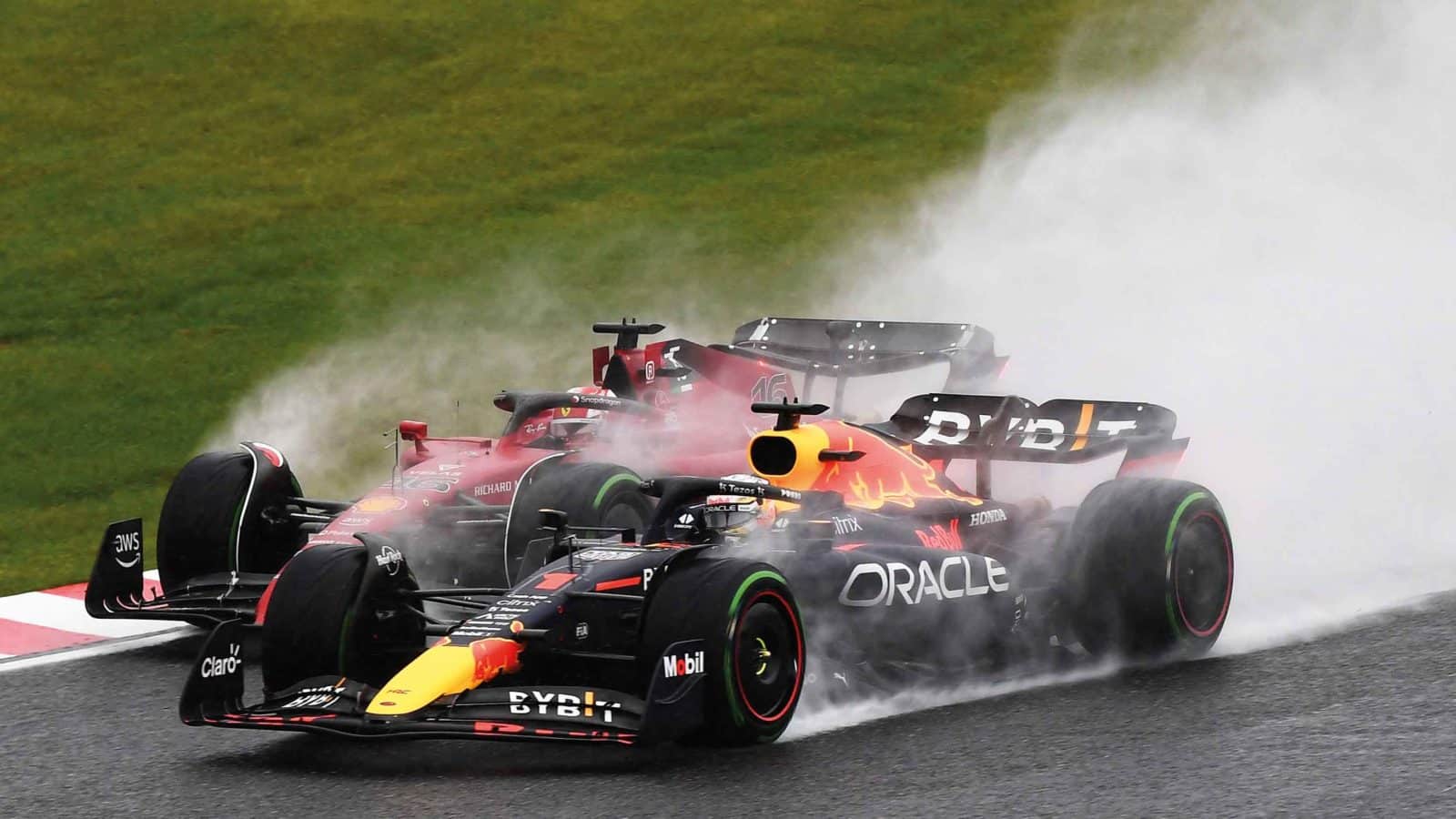
Max Verstappen and Charles Leclerc went wheel-to-wheel initially, before Red Bull reached a whole new performance plane
Getty Images
Even if only the 2022 victories of Max Verstappen counted, he’d still be comfortably in the top 20 of all-time career race wins in the sport’s history. That’s how statistically dominant he was. He scored more Formula 1 wins in this one season than Graham Hill, Jack Brabham or Emerson Fittipaldi did throughout their long careers. But it was only in the season’s second half that the scale of his performance superiority matched the race win stats which were being notched up. In the first half it was often Ferrari’s Charles Leclerc setting the pace.
Neither the Ferrari team nor the car were quite robust enough to carry the hopes that the speed of the F1-75 forced upon them. Ferrari corporate politics being what they are, it led to the resignation of team principal Mattia Binotto at the end of the year.
“Red Bull gave the greatest driver of his generation a dream car”
Not that Red Bull’s season was without controversy in the year during which the team’s founding owner Dietrich Mateschitz died. The breach of the 2021 cost cap incurred a penalty and created questions around its 2022 dominance. But even if the £400,000 or so by which it was over (once allowance is made for the erroneous corporation tax input) were applied to 2022, it wouldn’t even begin to explain Verstappen’s blockbusting season. This was founded upon one of the most potent team/driver performances that Formula 1 has ever seen. And with the RB18, Red Bull provided the greatest driver of his generation with a near-perfect tool for the job. It was the car he’d always dreamed of… eventually anyway.
In the first part of the season it was as much as 25kg overweight. The new generation of ground-effect cars were heavy even by the lardy standards of the hybrid era. The ground-effect floor has to be much stronger to withstand the aerodynamic forces it generates, the new bigger wheels and tyres are a lot heavier, as are the bigger brakes within them.
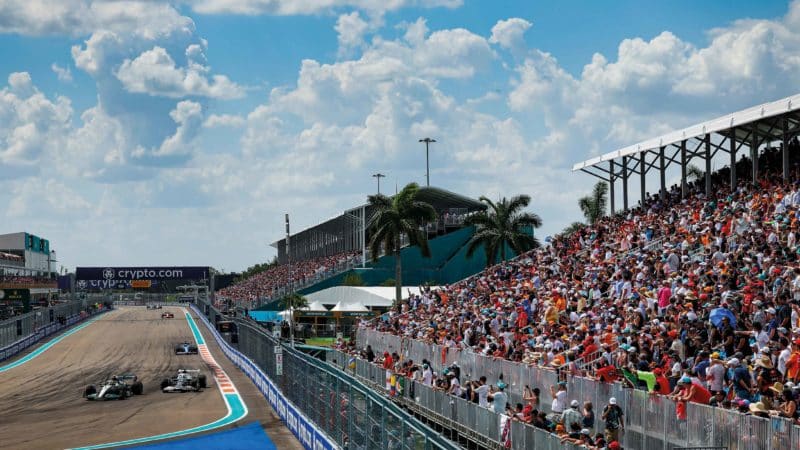
Miami made its grand prix debut.
DPPI
Only Alfa Romeo was down to the weight limit at the start of the season (courtesy of a physically smaller car than anyone else), but Red Bull was the heaviest of all. It began the season with a weight penalty over the Ferrari of around 15kg which in itself (i.e. regardless of how it is distributed) would be worth around 0.45sec of lap time around a typical track.
Yet even in those early races where Leclerc was winning races from the front, Verstappen was typically within a couple of tenths in qualifying – and right there hassling him in the race, even beating him in round two in Jeddah where the Red Bull’s straight-line speed advantage proved very valuable. So if the Ferrari was initially carrying 0.45sec-worth of weight advantage but only qualifying a couple of tenths faster… it potentially meant that trouble, in the form of Verstappen, was going to be coming for them. Just as soon as Red Bull could shed excess kilos.
The demands of the 2021 title fight and the late-season development had impacted upon the team’s preparations for ’22. Parts were created in the minimum of time rather than of the minimum weight and there hadn’t even been time during testing to conduct the usual run-dry test of the fuel system. There was the big bodywork upgrade in the final day of testing to correlate instead. That played its part in the double retirements in the late stages of the opening race in Bahrain as fuel still in the tanks didn’t reach the engine. When an unrelated fuel leak put Verstappen out of a distant second place in Melbourne for round three, Verstappen’s assessment of the season ahead was not a rosy one. “I don’t even think about [trying to win the championship from this position]. At the moment, there is no reason to believe in it.” This was just before he won the next three races: Imola, Miami and Spain.
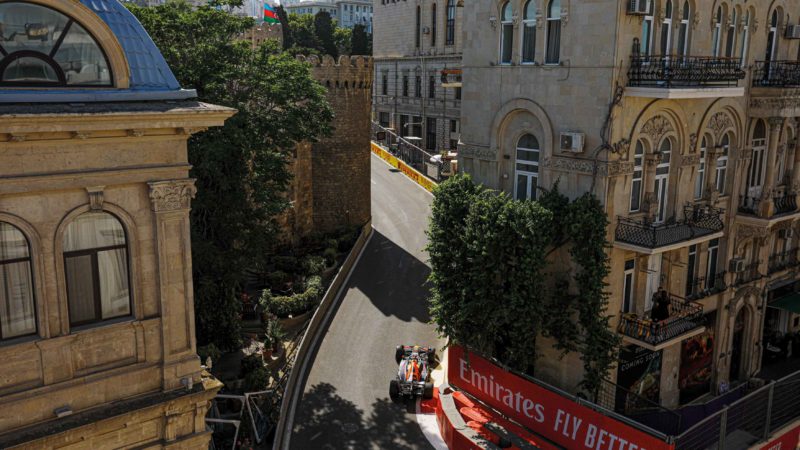
With 15 wins in a single season, Verstappen set a new record. Baku was his fifth of the campaign
The weight was steadily coming off the Red Bull as new lightweight components were built, but still the Ferrari was a powerfully competitive machine. At Barcelona, Verstappen – who’d been through the gravel trap early in the race – only won after Leclerc retired from a commanding lead. This was to be the first of a crippling series of power unit failures for Ferrari. The following race at Monaco – which should have been won by Leclerc at a canter – exposed the team’s other weakness: strategy calls.
The way each of these cars delivered their performance was quite different. The Ferrari had a medium-high speed downforce advantage, great agility into slow corners and a super-strong power delivery from low speed. At slow-corner speeds the Red Bull, although not as agile as the Ferrari and with more of an understeer balance, seemed to retain more of what downforce it did produce – and was much quicker at the end of the straights.
“Monaco exposed Ferrari’s weakness in strategy calls”
Ferrari’s response to the new aero regulations was very different to Red Bull’s. The F1-75’s wide, bluff sidepods out-washed the airflow away from the floor edges to enhance the floor’s performance. There was space within the sidepod’s wide frontal expanses to house most of the radiator area, keeping it low down. The Red Bull by contrast had some radiator cooling up beneath the engine cover, around the car’s centreline, in order to facilitate a slimmer sidepod front with an extensive undercut to help accelerate the air down the bodysides. The upper surface of the Ferrari’s big pods had a deep channel within them, manipulating the air pressure and hurrying the air towards the rear wing.
Top 10 drivers of the year
No surprises as to who’s number one, but who else makes our list of stand-out performers?

1. Max VerstappenThere wasn’t any headroom for him to become faster. But the RB18 gave him the luxury of not having to pounce on every opportunity. At Spa, with lots of front end in the fast bends, he was peak Schumacher. Unbelievably good. |

2. Charles LeclercSome of his pole laps in the oversteery Ferrari were high-wire feats of virtuosity and he has a way of overlapping brake and throttle, which was extra-valuable in this car. Could have won five races in succession on merit. |

3. Lando NorrisThe McLaren was an ill-balanced, inconsistent car but that fact was largely hidden because of Norris’s ability to somehow squeeze a lap from it. An absolutely flawless season. |

4. Lewis HamiltonHis least convincing season largely because in the first half the W13 pulled the rug from beneath him and he was searching for a route to competitiveness even if that search meant compromising a race weekend. |

5. George RussellPredictably brilliant in his first season in a top team, even if it didn’t give him the level of car he was expecting. Kept it simple and ran with Hamilton, sometimes ahead, sometimes behind. Wonderful high-pressure win in Brazil. |

6. Fernando AlonsoThere’s very little between any of the top six in this list and Alonso is only at the tail of it because the competitive striving could still go over-the-top, like in Brazil. As fast as he’s ever been and still unbelievably good racecraft. |

7. Carlos SainzThe demands of getting the last couple of tenths from the F1-75 were very specific and Leclerc’s ability to tune straight into them left Sainz a little dazed. He came back in the latter half, but by then the car was no longer as competitive. |

8. Esteban OconHe held his own against Alonso but it was a stretch. Very often he’d only reach Alonso’s pace by the end of qualifying. Had a couple of terrific races, Spa notably, but also a couple of mediocre ones. Outscored Alonso only through reliability. |

9. Sergio PérezHe’d have been a couple of places further up if the season had run only until Baku. But as the RB18 developed into a more responsive car, so Checo fell a long way off Verstappen’s pace. The inverse of Sainz’s season. |

10. Alex AlbonSome great against-the-odds points finishes in a car which didn’t deserve it, over-qualifying the car, then keeping faster ones behind him by shrewd use of the strong straight-line speed, which came with the lack of downforce. |
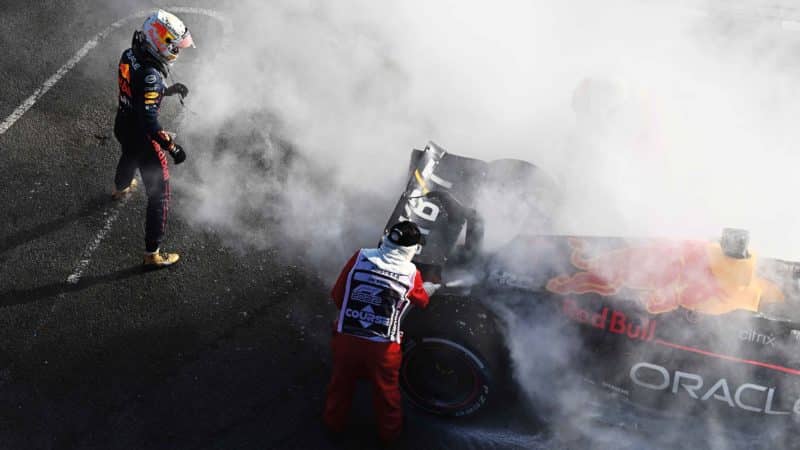
Early season failures gave Ferrari hope,
Getty Images
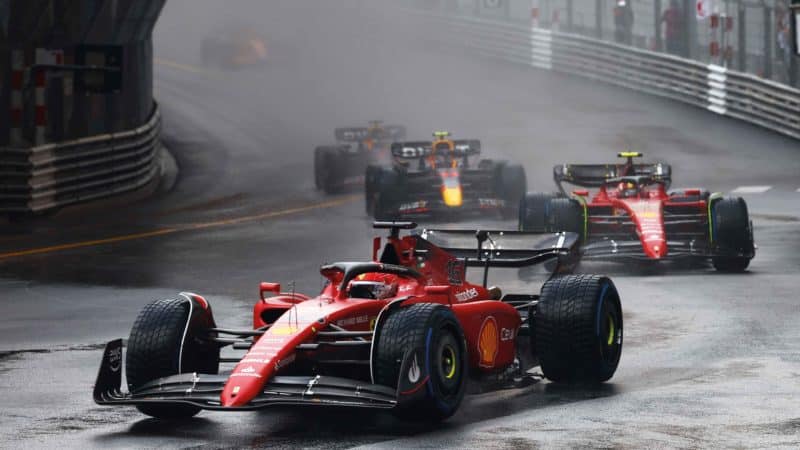
Hope quickly faded as the team’s strategy faltered in Monaco.
Getty Images
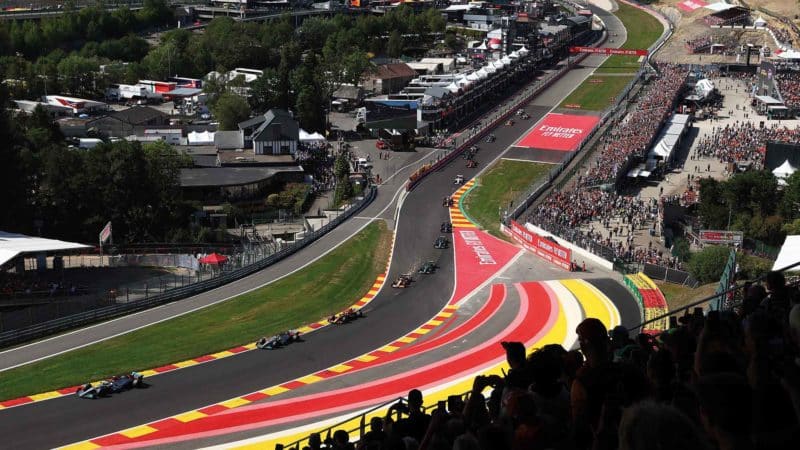
Red Bull was dominant by Spa, below
Getty Images
The floors of each car were quite different too. The Red Bull’s tunnels were higher and more arched than those of any other car. The flat central keel separating the tunnels was not of the simple teardrop shape adopted by everyone else, but with lots of angular changes along its length. It appeared as if these two features combined to keep the volume of those tunnels more consistent – which, if so, would certainly make them less prone to stalling at low ride heights, which might explain the RB18’s unique absence of porpoising. This aerodynamic phenomenon – familiar from the 1980s – is triggered when the floor essentially stalls as the gap at the tunnel venturi throat becomes overwhelmed by the mass airflow being pulled into it by the exponential change in pressure as it nears the ground. The car then rises on its suspension, un-stalling everything and beginning the process all over again. The Ferrari suffered from it, but would switch off as soon as the driver stood on the brakes.
The Red Bull seemed to derive more of its performance from the underbody and typically would utilise smaller wings than the Ferrari. GPS traces suggested the Ferrari’s peak downforce was higher, together with proportionally greater drag. But the Ferrari could accelerate out of the corners faster, and that was almost certainly a function of its radical new power unit. Still with a combined turbine/compressor (the only one of the four PUs not now with a split turbo) it was highly distinctive in its use of a small turbo and long inlet tracts, part of the idea being to reclaim the low-speed torque lost to the stipulation of 10% biofuel. Initially it combined this with greater top-end power than the Honda, Mercedes or Renault PUs, but another Leclerc engine failure when apparently on the way to victory in Baku forced a rethink in how it was run. The source of the problem was the MGU-H and the solution was not a quick fix. It would be essentially detuned for the remainder of the season. It remained a very competitive PU, but without the significant advantage it had conferred up to this point. Power unit grid penalties for both Leclerc and Carlos Sainz would also take the sting out of its challenge.
Baku was the third consecutive race Leclerc should have won and the beneficiary every time was Red Bull, usually Verstappen, but not at Monaco where it was team-mate Sergio Pérez who triumphed. Not without significant internal turmoil though. Verstappen believed that Pérez had crashed deliberately at the end of qualifying to protect his grid position ahead of Verstappen. That this should then be the foundation of Pérez’s victory probably just aggravated things even further.
Pérez had come into the season much more in-tune with this car than last year’s more aggressively responsive RB16B. In contrast to Verstappen he liked its understeer balance. Max felt the trait placed a false ceiling on his speed and Pérez was far closer to him than had been the case last year, even before Monaco. Changes were demanded in the Verstappen camp and for Canada the car was significantly lighter, which brought with it a change in its balance. Much of that saved weight was towards the front and now the front tyres were no longer so overwhelmed, giving Verstappen the strong front end he sought. Suddenly, Pérez was no threat as he struggled to get anywhere near Verstappen.
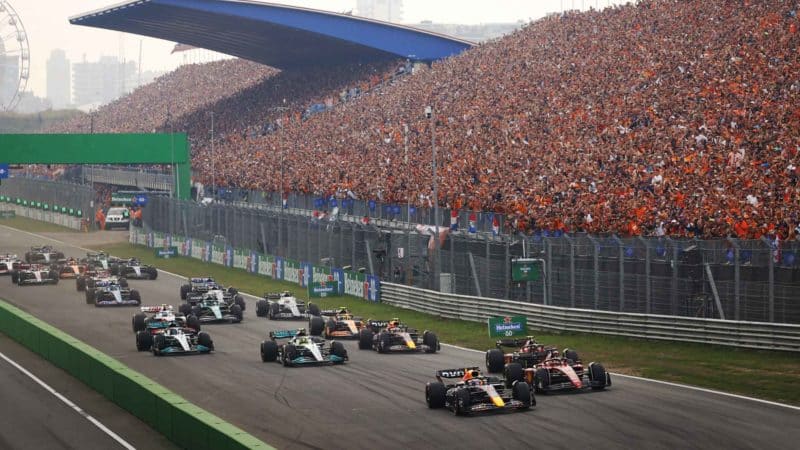
Verstappen leads the way at Zandvoort in front of a packed mass of orange-clad supporters
Getty Images
The car just got better and better from there and with the Ferrari further declawed by the technical directives made by the FIA to address the bouncing problems (which finally came into effect at Monza), there was no stopping Verstappen. His margin of superiority at Spa was breathtaking. Despite starting a penalised 14th, he was leading and pulling away by just one-third distance. He set the fastest lap of the race still with around 30kg of fuel on board and medium compound tyres. Had he not been taking PU penalties, he could likely have been on pole by around 1.5sec.
Leclerc became steadily more exasperated by the decline in his car’s competitiveness and some of the more blatant strategic errors – the pitwall lost him wins at Monaco and Silverstone and left him 10th on the grid in Brazil. Sainz was more proactive in controlling the pitwall from his cockpit and this was a crucial part in him taking his first grand prix win – at Silverstone. He was initially somewhat dazed at how Leclerc’s intricate overlapping of throttle and brakes got so much lap time from this particular car, and it took him half-a-season to get on terms. By which time the car was no longer the speed monster it had been early on.
No mention yet of Mercedes. It was a pretty disastrous season for the eight-time constructors’ champions, with just a solitary race win, scored by George Russell in Brazil, the penultimate race. The team had completely failed to anticipate the banana skin of porpoising and in the configuration of its car had denied itself the tools to extricate. In simulation the W13 gave fantastic downforce figures which, if they had translated, would have left Red Bull and Ferrari far behind. But in the real world they were never achievable. To run the car away from the porpoising threshold required a greater ride height than it had been designed around. The rear suspension did not have the required range to deal with that and so had to be run extremely stiffly, even by the stiff standards of this generation of car. This induced a mechanical resonance which triggered a bouncing quite separate from the aerodynamic porpoising. The car had to be so stiff, it ended up stiffer than the tyres, which caused it to then bounce on the rubber too. Because the floor couldn’t be allowed to run as close to the track as it was designed to, bigger wings had to be used, making the car very draggy.
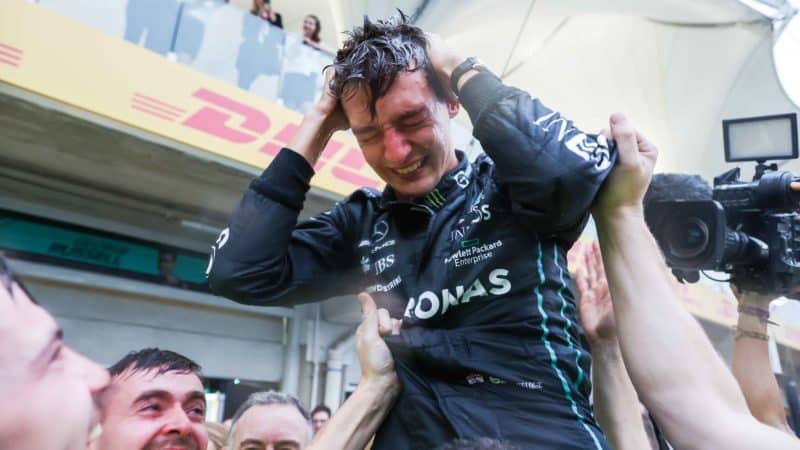
Raw emotion, or just champagne in his eyes? Regardless, Russell’s breakthrough win in Brazil was immense
Getty Images
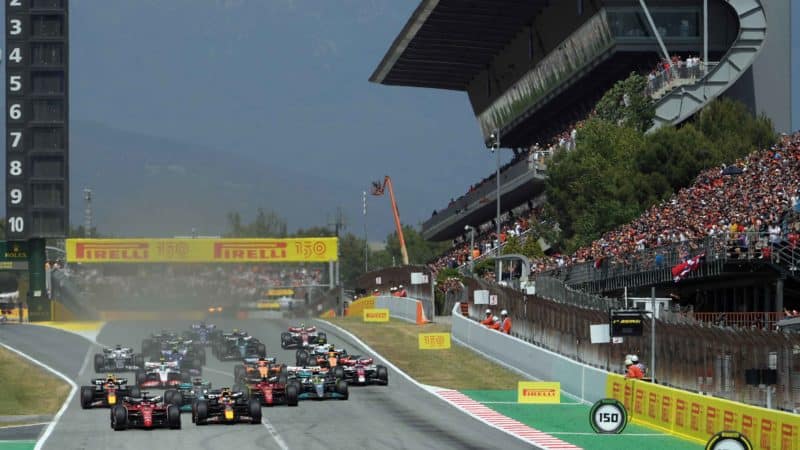
Leclerc leads from pole at the Spanish GP but Max would win
Getty Images
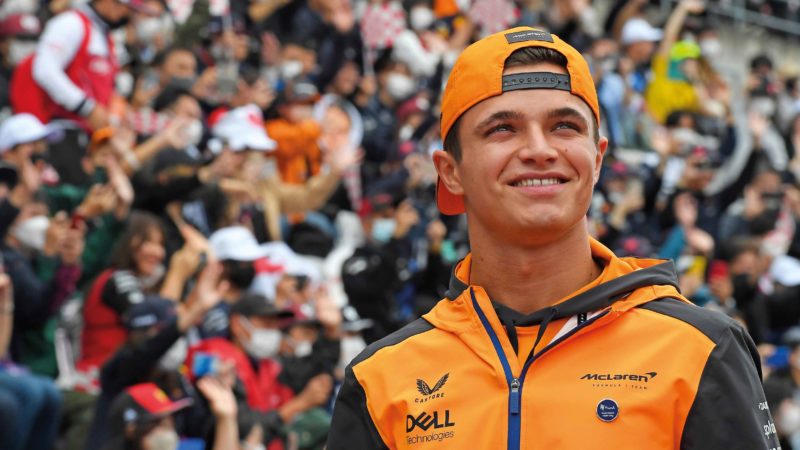
Impressive season from McLaren’s Lando Norris
Grand Prix Photos
But it did have good downforce, and if the circuit layout favoured it, it could be made quite competitive, especially in the late season once the team had got a full handle on the narrow window in which it insisted it be run. Together with a new floor and a weight loss introduced at Austin, it was enough to make the car a contender there, Mexico and in Brazil – where Russell led Lewis Hamilton to a team 1-2, resolute and brilliant under pressure from a fresher-tyred Hamilton over the last few laps after a safety car restart. That was on a rare weekend when Red Bull had got its set up wrong, however. Hamilton’s early season was spent trying all sorts of weird and wonderful set ups, trying to decode the car, while Russell as the new boy just sought to maximise each weekend. Consequently they were very closely matched in the first half-season, Russell well ahead on points also thanks to a couple of opportunely-timed safety cars. With the car spec more settled, there followed a 10-race sequence where Hamilton was invariably the faster qualifier and Russell freely admitted he was not dealing as well as his team-mate with the car’s twitchiness on corner entry. He regrouped after a disastrous Austin race and came back strongly.
“Hamilton’s early season was spent trying the weird and wonderful”
The new regulations were partly successful in that they did make following closely easier. There were around 25% more overtaking moves made. But the aim of closing up the field was not met. Alpine and McLaren vied as best of the rest, around a second per lap adrift of the front. Fernando Alonso rolled the clocks back and qualified the Alpine on the front row in the wet of Canada. Alpine’s fourth place in the constructors’ championship was deserved, but its new split-turbo power unit suffered some niggling reliability problems, invariably on Alonso’s car. Lando Norris flattered the ill-balanced McLaren massively and finished off the career of the still-struggling Daniel Ricciardo, who doesn’t get to complete the final year of his contract.
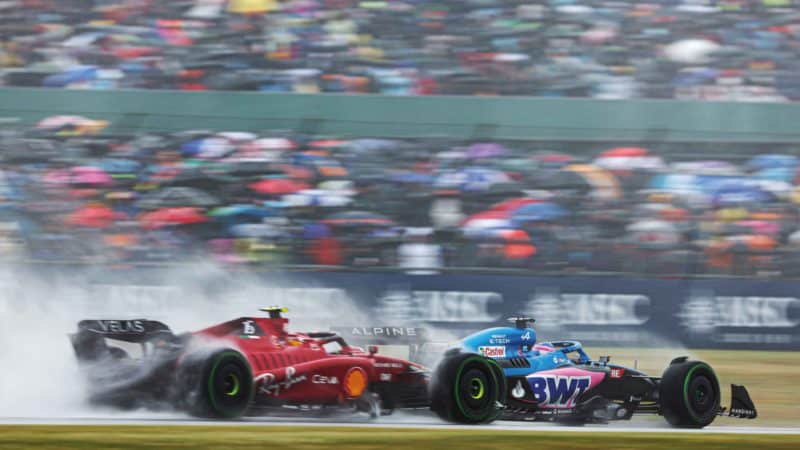
Leclerc and Alonso put on a show during the British Grand Prix, but the weekend would belond to Sainz, who scored both his maiden F1 pole position and victory
DPPI
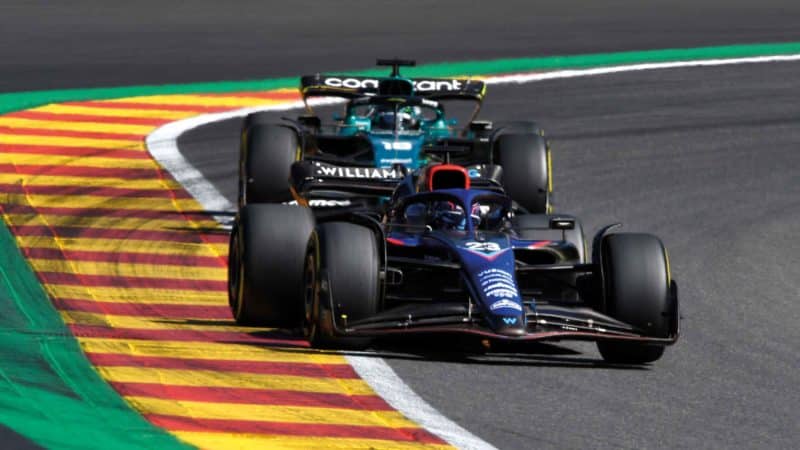
Alex Albon grabbed the odd point
Getty Images
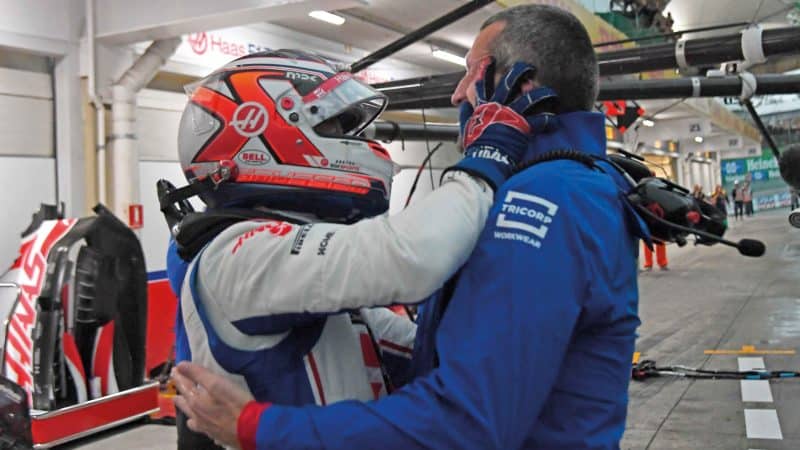
delight for Kevin Magnussen with pole in São Paulo
Grand Prix Photo
That midfield was extremely tight and essentially consisted of the rest of the field at various times. Alfa Romeo with its light car allowed Valtteri Bottas some good days at the head of that sub-pack but the team’s operations were chaotic. Zhou Guanyu made a decent rookie season as Bottas’s team-mate. Aston Martin and Williams each misjudged the hazards of ground effect badly enough that they prepared hastily redesigned cars, debuting at Spain and Britain respectively. Sebastian Vettel in his final season was patchily terrific in the former, Alex Albon was regularly great at keeping a big DRS train of faster cars behind him to scrabble the occasional point for Williams. AlphaTauri was a long way from its form of last year, with an understeer-blighted car Pierre Gasly could get very little from. Haas could be at the front of the midfield pack just as readily as at the back and Mick Schumacher didn’t do enough there against the returning Kevin Magnussen to stay on the grid next year. Russia’s invasion of Ukraine earlier in the year led to the cancellation of Nikita Mazepin’s contract and thereby played its part in a Haas qualifying on an outlier pole in Brazil, courtesy of Magnussen. That damp circuit anomaly gave a brief respite to the pummelling sequence of Verstappen victories as history was made.

